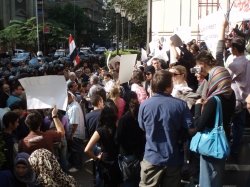Issue 19, fall 2014
https://doi.org/10.70090/MB14NECV
Abstract
From documenting the war in Syria to capturing police killings in New York City, citizen videos are exposing important events and becoming part of the fabric of the media ecosystem around the world. Yet for newsrooms and journalists, traditional protocols and practices do not adequately address the editorial, ethical, and technological complications of using citizen videos. Issues of trust, consent, preservation, and safety must be reconsidered when videos are captured by amateurs, uploaded by anonymous individuals, and managed by the policies of technology companies. In the spring of 2014, an online video of sexual assault in Egypt, and its circulation by international news media, encompassed many of these emergent challenges. While the viral video put sexual violence at the top of newly inaugurated President Abdel Fattah al-Sisi’s agenda, it also exposed the potential of eyewitness video to re-victimize individuals on camera, disappear from YouTube, and lead to more questions than answers surrounding the issue it documents. Legacy and new media outlets reported on the video in a variety of ways, demonstrating the inconsistencies of reporting with citizen footage and highlighting the need for new tools and guidelines to facilitate its safe, effective, and ethical use. As citizen footage becomes an essential and ubiquitous medium for social documentation, the video offers one case study of the serious concerns that must be addressed, not only by the news industry, but also by technology companies, civil society, and the public at large.
Introduction
On June 8, 2014, Cairo’s Tahrir Square filled with supporters of Egypt’s newly elected President Abdel Fattah al-Sisi to celebrate his inauguration. As is relatively common for large political rallies in Egypt today, the event was marred by violence against women. The monitoring collective, I Saw Harassment, documented five incidents of sexual assault, four of which required medical support.[i]
For years, both local and international women’s rights groups have documented sexual violence in Egypt and pressed for justice, but the crimes have continued with impunity. That night, though, something changed. A video of a sexual assault was uploaded to YouTube on Sisi’s inauguration day. While the amateur footage is shaky and poorly lit, it appears to show a woman naked, reddened, and bruised among a chaotic crowd of men in Tahrir Square. As the BBC’s Dina Aboughazala stated, “What makes this incident really grave is that never before have we seen a woman stripped naked and documented in a video.”[ii] Within hours, the video went viral worldwide, overshadowing the inauguration ceremonies, and catalyzing a swift and serious response by authorities. Seven men were arrested immediately, and President Sisi spent much of his first week in office addressing the issue of violence against women.
The video is the latest in Egypt's history of online video as a tool for human rights documentation and advocacy. No chronicle of the Arab Spring is complete without a discussion of the critical role played by citizen journalists covering the Egyptian revolution in the absence of free and independent media. Dating further back, when bloggers shared videos of abuse in police stations in 2006, the footage added pressure to domestic and international campaigns against torture, resulting in the imprisonment of two officers, and the increase in mainstream media coverage of the issue.[iii] Like previous cases of online human rights video in Egypt, the circulation of the 2014 sexual assault footage was not without controversy. The editorial, ethical, and technical challenges that emerged highlight many of the unresolved gaps in using citizen video as a safe and effective form of human rights documentation.
Addressing the Challenges of Reporting with Citizen Videos
Whether documenting police abuse in the United States, chemical weapons in Syria, or a sexual assault in Tahrir Square, video footage captured by eyewitnesses and shared online is shining light on abuses in new ways, and providing valuable visual documentation for journalists, as well as human rights investigators and crisis responders. It allows news outlets to report on places and scenes their own correspondents don’t have access to, such as conflict zones, prisons, protests, or, most commonly, breaking news scenes where reporters have yet to arrive. Still, for an industry founded on credibility and imbued with a sense of ethical probity, reporting on and publishing videos taken by amateurs (often described as “user-generated content,” or UGC) poses a host of challenges. Eyewitnesses bear no pretense to journalistic objectivity, and their credentials for honesty and trustworthiness are unknown to those watching their footage online; they are likely unfamiliar with ethical concepts such as informed consent, and unaware of digital security risks involved in sharing and storing sensitive information; they may not have archived a backup of their footage, which, online, is subject to removal on the basis of technology company policies or the willingness of those companies to comply with local authorities.
These discrepancies between journalistic standards and the practices of citizen filmers have led to what has been described as a “wild west” in the way news outlets report with citizen footage.[iv] It is an emerging subset of journalism “without rules or structure,”[v] involving innovation, experimentation, and a host of mistakes along the way. Some of the world’s most respected news outlets have reported on citizen videos that were later shown to document something different than what was originally indicated. In late 2013, for example, a correction in The New York Times explained that a video that formed the basis of an article by veteran war reporter C.J. Chivers was actually a year older than reported.[vi] Other outlets, however, never discover or publish those mistakes. A September 2013 article on Al Arabiya’s English language website features an online video purportedly showing a massacre in Iraq. It remains on the site a year later, despite the fact that the video has since been identified as edited from clips dating at least as far back as 2011.[vii]
Along with the challenge of verifying online video, news outlets have struggled to define their relationship with and responsibilities to citizen reporters. In one tragic case a Syrian citizen journalist, who sold photographs to Reuters, died while shooting a battle in Aleppo. Many have questioned whether the teenager was appropriately trained and prepared to document war, and if the payment incentivized him to take risks that cost his life.[viii]
News outlets must also now consider legal obligations to the creators of online content. Some outlets ask filmers for permission to use their footage, and then broadcast those videos on their own platforms. In a pioneering and exhaustive study of UGC in news media by the Tow Center for Digital Journalism, researchers found that those conversations are commonly comprised of a few lines on Twitter, in which a news producer asks a stranger permission to use a clip in 140 characters or less.[ix] The medium doesn’t lend itself to in-depth conversations about rights, credit, compensation, and the implications of publishing content to a worldwide news audience. The practice has caused debate within newsrooms, and many in the industry fear that it is only a matter of time before a filmer takes a news outlet to court for not giving proper credit, jeopardizing the future use of UGC by news outlets entirely.[x] For newsrooms, the challenge is not only how to properly acquire permission to use citizen video, but how to identify the original filmer to grant that permission. “Citizens are posting copyrighted material without permission. And the creator of some material cannot be identified,” states a 2012 Pew Research Center report on YouTube and news.[xi] “All this creates the potential for news to be manufactured, or even falsified, without giving audiences much ability to know who produced it or how to verify it.”
Many online news outlets sidestep the question of copyright by embedding the YouTube citizen videos into their articles or featuring them on their website, rather than copying them onto their own platforms. However, if and when an uploader’s account is suspended or videos removed from YouTube, articles are left without what may be a critical component, and readers have no record of the information now missing from the story. This leads to an additional concern regarding citizen video as a form of human rights documentation—the risk of losing such footage due to alleged violations of the policies of online hosting platforms. When news outlets were entirely responsible for producing the reports that made up their content, their reports produced archives that in turn could become a source of material for filmmakers, historians, and legal investigators. With citizens now producing much of the source material for news, the historical longevity of their footage is uncertain. For instance, the videos of torture in Egyptian police stations distributed in 2006 by Egyptian blogger Wael Abbas were temporarily removed from YouTube for violating the site’s policy against graphic violence.[xii]
Finally, in addition to the rights of citizen filmers, are those of individuals caught on camera in videos that can potentially be shared around the world. Many videos shared online are filmed in private settings, or in institutions where individuals lack full autonomy over their actions. Do prisoners, for instance, have the right to consent to footage of their abuse shared publically? Can parents prohibit the sharing of videos showing the murder of their children? What kinds of videos will endanger, revictimize, or stigmatize the individuals identified in them? As news outlets no longer play the lone role of gatekeeper to determine which videos are broadcast to the public and how, these are some of the questions that civil society groups, tech companies, and the media are trying to understand.[xiii]
In light of these concerns and cautionary tales, several new initiatives have emerged in the media industry, as well as the human rights and crisis response fields. They aim to develop guidelines, tools, and ethical codes to help incorporate citizen media into reporting while upholding traditional professional standards. In 2013, the Online News Association (ONA), a professional journalism association with chapters in the U.S. and Europe, created a working group on ethics to identify the challenges of what it calls “social newsgathering,” and develop guidance and solutions to address them.[xiv] The Verification Handbook, published in early 2014 by the European Journalism Centre, is one of the first resources for journalists to address the challenges of working with citizen reports. The book compiles wisdom, tools, and practices from newsrooms and other industries on how to verify citizen footage and address ethical issues in using it. In addition, three months after the release of the Tow Center report on UGC footage in news, the study’s authors launched the Eyewitness Media Group, which aims to expand upon their initial research and develop solutions to the identified problems.
Reporting on a Citizen Video of Sexual Assault
The disturbing video of a sexual assault in Egypt entails many of these emergent concerns, including verification, consent, preservation, and the role of YouTube and state authorities. The numerous ways that outlets addressed (or overlooked) these issues provides a contemporary illustration of the “wild west” environment of citizen video usage by the news media. Considering the immense reach and impact of this video, understanding how these challenges played out provides a valuable case study in methods of utilizing citizen video in journalism, and gaps in safely, ethically, and effectively doing so.
To begin, the issue of verification: Where and when was it filmed, and who was behind the camera? Because the video was uploaded to YouTube on June 8, and appeared to take place in Tahrir Square, where sexual assaults were reported that day, many viewers and news outlets assumed the video was of one of the attacks reported at inauguration rallies. An article by The New York Times on June 9, for instance, reported that “the mass assault captured on video was occurring Sunday night.”[xv] Al Arabiya described “outrage sparked by a graphic video of the attacks” of June 8.[xvi] Other outlets, such as the BBC and the Associated Press, hedged their reports by indicating that the video “allegedly” or “purportedly” showed a sexual assault during Sisi’s inauguration.[xvii] Ahram Online more thoroughly explained questions surrounding the video’s origins in its June 9 report on sexual assaults documented during inauguration rallies. “The date of the video, which does not show the victim's face, has not been yet verified – some say that it was shot on Saturday during other El-Sisi celebrations and then uploaded on Sunday. Others claim that it is old footage from 2012.”[xviii]
The news company, Storyful, specializes in verifying citizen reports of breaking news. It traced the viral YouTube video back to an earlier version posted to Facebook.[xix] The BBC came to the same conclusion, explaining that an Egyptian Facebook user stated that he found the video online a few days prior to the inauguration.[xx] The original source and date of the video remains a mystery, though visual clues appear to corroborate that it was indeed filmed in Tahrir Square. It appears to be an example of what is becoming a common case of an authentic yet old video being used (either deliberately or by mistake) to represent a current news event. For the most part, this detail was lost in the international news coverage of the video and the reports of sexual violence that took place during the inauguration rallies.
Verification questions aside, news outlets had to determine how to report about the video. Online publishing has created novel ways for news reports to reference their sources, such as hyper-linking or embedding third-party content. For this story, the graphic and sexual nature of the video further complicates the decision of how and whether to point viewers to the video. Newsrooms have a tradition of withholding the names of survivors of sexual violence, even if reporters know the person’s identity, to prevent further harm or trauma. But the decision to withhold information (in this case, visual information that could reveal the victim’s identity) is more challenging when that information is already disclosed on social media in videos available online.[xxi] When journalists gather information for a story, they can clarify with sources if any special agreements are needed for the exchange, such as an embargo of information or a request for anonymity. But when everyday citizens, rather than journalists, gather information that forms part of a news story, outlets are no longer in direct contact with the sources, and must develop other ways to determine the terms of sharing information with their audience.
In online articles published the day after the inauguration, many mainstream outlets such as The New York Times and the BBC described the video, but provided no link to YouTube nor a clip of it on their own site. Al Arabiya’s June 9 post on its English language site featured the video with a short article about it below. However, the outlet hosted the video on its own media player, and added a blurring filter over segments that exposed the victim’s body. A Reuters update of the story published in the New York Daily News a few days later included still images of the video, which are too blurry to make out any details.[xxii] Online-only news sites are more likely to follow the blogging convention of linking to and embedding third-party content referenced in their articles. The graphic and sexual nature of this video did not necessarily change that decision. Mashable, for instance, embedded the YouTube video at the bottom of a June 9 Associated Press article. Just above the video was a warning in bold text: “Parts of this video contain graphic content.” Yet within a few days of the video’s posting, the uploader had removed the clip. Thus, on Mashable’s website, the embedded video box is black. When the play button is clicked, text appears stating, “This video does not exist.”
This leads to the next challenge, which is the role of technology companies in determining the possibilities and limitations of citizen footage. YouTube’s community guidelines outline prohibited content. “Graphic or gratuitous violence is not allowed,” states one of the rules. “Don’t post videos showing bad stuff like animal abuse, drug abuse, under-age drinking and smoking, or bomb-making.”[xxiii] While unedited footage of a sexual assault would seem to fall under those broad rules, YouTube allows room for nuance in its enforcement, and considers the intent of the video in its decisions about removing content. A post on the official YouTube blog spells out those considerations, stating that the company “(allows) graphic videos that are intended to have news or documentary value.”[xxiv] How does an uploader convey intent? The blog goes on to explain, “context is king.” If the video’s description, title, or narration makes clear that it is intended for documentary value as opposed to gratuitous violence or anything else, the enforcement team is more likely to let the video remain. Several versions of the Tahrir video were removed because they violated YouTube’s policy on nudity and sexual content. Subsequent versions remained, including ones that blur the victim’s body, or, like a short BBC video, includes raw clips edited with context of the sexual assault footage.[xxv]
YouTube policy as it relates to this video goes beyond enforcement of its community guidelines, and includes the company’s response to political pressure. Following the domestic and international uproar caused by this video, not only were several men arrested, but President Sisi visited one of the assault victims in the hospital. He called upon YouTube to remove the video, stating that the request came from the victim herself.[xxvi] However, many Egyptian women’s rights activists questioned his sincerity. Reports that Egyptian prosecutors were investigating the filmer and uploader suggest that the government’s problem was not only with those responsible for the assault, but with those who exposed such abuse in the first place.[xxvii] YouTube refused to remove the video outright, allowing footage of the assault that protects the victim’s privacy to remain. The ability of YouTube to decide whether footage of a sexual assault remains in the public sphere demonstrates the significant role of technology providers in facilitating human rights documentation.[xxviii] YouTube’s decision in this particular scenario reflects a nuanced understanding of both the risk of re-victimizing a survivor of sexual violence and the value of preserving documentation of an assault. From Facebook and Twitter to WhatsApp and SnapChat, a growing number of technology companies are playing the role of facilitator in the documentation of social events. For news organizations, the way such companies understand that role and appreciate the value of citizen footage can have a significant impact on the ability to utilize eyewitness video.
Conclusion
Within two months of this video emerging online, nine men were sentenced to life in prison for their involvement in sexual assaults, and three more received at least twenty years behind bars. Only time will tell how committed President Sisi is to combating violence against women, but what is clear now is the impact an online citizen video had in garnering the mass attention needed to pressure authorities into action. Considering the potential of citizen video to document abuse and spark change, it is incumbent upon civil society to review and strengthen the infrastructure that facilitates the verification, distribution, and preservation of such footage.
The potential of not only a general audience, but also journalists, to misconstrue videos as documenting something they are not is significant, as is the likeliness that those errors will undermine legitimate eyewitness footage of abuse. The ease with which videos can disappear from the public must also be addressed. How can citizens, activists, bloggers, and news outlets, share footage of abuse without exposing victims to more harm, or risking that the footage will be removed for violating online policy? How can news outlets, which have traditionally provided not only coverage of current events, but an archive of history in the making, ensure that the online citizen footage that is playing a growing role in news coverage, is preserved? These urgent questions beg answers not only from the news media, but from the fields of human rights and crisis response, for whom citizen footage is also a potential, and challenging, new tool for documentation.
 Arab Media & Society The Arab Media Hub
Arab Media & Society The Arab Media Hub





